
Acne Scars: Causes, Tips, and Treatment
Wondering how long it takes for acne scars to fade, how long it takes acne scarring to heal, and what is the best treatment for acne scars? Read here.
Acne Vulgaris (commonly known as acne) affects an estimated 650 million people worldwide[i]. It is a common skin complaint in the United Kingdom[ii], and reportedly affects more than 80% of people at some point in their life and leads to approximately 3.5 million consultations with GPs each year[iii].
Acne is a multifactorial disorder of the pilosebaceous units (PSU) of the dermis. Pilosebaceous units are found in all parts of the skin except for the palmar and plantar surfaces (Montagna, 1963). They are most dense on the scalp, face, neck and shoulders[iv], many of which are common areas for acne to present.
Increased sebum production causes hyperkeratinisation of the hair follicles and cultivates an environment for bacteria to grow. In turn, this triggers skin inflammation and an immune response that manifests as what we know to be acne[v].
Acne’s prevalence has been amplified in recent years as a result of the ongoing global pandemic. The portmanteau ‘maskne’ entered general vocabulary as recurring lockdowns and mandatory mask-wearing affected many people’s skin health due to the stress, anxiety and lack of sleep they were experiencing.
What is an acne scar?
Acne scarring is a common side effect of acne and affects one in five people who have suffered with the condition[vi]. As with all scarring, acne scarring can have a psychological[vii] and psychosocial[viii] impact on patients evoking lots of different emotions including embarrassment and anxiety and can lead to frustration and a loss of self- confidence. It can affect all aspects of a person’s life, including work-life, with some research suggesting that ‘people who develop acne scars feel their appearance interferes with their professional relationships and chances of future employment’[ix]. Any potential psychological and psychosocial consequences should be taken into consideration when consulting with patients as this can have an impact on treatment options and plans.
Formed in the proliferation and matrix remodelling stages of the wound healing process of active acne[x], acne scars form due to reconstructive collagen synthesis of the skin’s Extracellular Matrix (ECM). There are three types of acne scar (atrophic, hypertrophic or keloid) depending on whether there is a loss or gain of collagen during this process[xi]. Patients can often experience more than one type of acne scarring and understanding the different types of acne scarring is important when assessing the individual treatment needs of the patient. We shall explore the different types of scarring in further detail later on in this article.
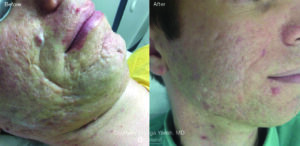
The difference between acne and spots
The terms acne and spots are often used interchangeably, and the exact difference between acne and spots is often a cause for confusion. In simple terms, the main difference between acne and spots is that acne is an inflammatory condition, and spots are a symptom of acne. There are different types of spots caused by acne that include blackheads, whiteheads, papules, pustules, nodules and cysts. Cysts are considered by many to be the worst type of spot caused by acne and carry the greatest risk of causing permanent acne scarring.
Acne Marks vs. Acne Scars: What’s The Difference?
Commonly known as ‘acne marks’, post-inflammatory hyperpigmentation (PIH) is caused by the overproduction of melanin after cutaneous inflammation. PIH manifests as patches in the same distribution as the initial inflammatory process and epidermal hypermelanosis will appear tan, brown, or dark brown and may take months to years to resolve without treatment. [i]
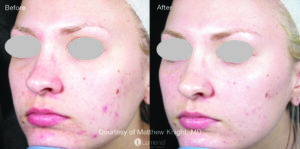
Acne scars are textural as opposed to pigmented in appearance and cause permanent structural damage to the dermis caused by the body’s reparative collagen synthesis. These fibres are different in texture to the surrounding tissue and cause the appearance of a scar. They can occur simultaneously and although both occur as a result of cutaneous inflammation, ‘acne marks’ and acne scars are visually different and require different treatment protocols.
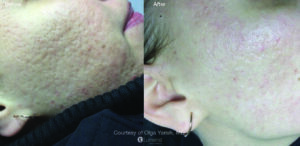
What is acne scarring not?
It’s important not to get skin discolouration and scarring confused as the treatment that the two symptoms of acne require are completely different. Acne scarring is not discolouration or a brown spot. Although discolouration is a visible reminder of acne, it is a temporary change to the skin as opposed to a textural change such as with scarring.
What causes acne scars?
As previously established, acne scars are formed in the proliferation and matrix remodelling stages of the wound healing process of active acne[i], acne scars form due to reconstructive collagen synthesis of the skin’s Extracellular Matrix (ECM).
This process can be exacerbated by many different factors and understanding these factors will help to decipher the most effective course of treatment. In addition, as limiting the chances of acne occurring in the first instance will consequently help to prevent the likelihood of scar formation so this should be factored into any treatment plan and patient discussion.
The chances of acne scarring can be heightened by factors such as squeezing acne spots as this can push bacteria and pus further into the dermis and cause a heightened inflammatory response that can take longer to heal and increase the likelihood of scarring. In addition, extrinsic factors such as sun damage can affect scar tissue’s ability to heal and can make additional complications such as PIH worse.
Acne scar prevention
Advising patients how to prevent acne scars forming in the first place is an important part of any acne management programme and should be discussed to try and avoid further scarring events from occurring. Patients should try to:
- Avoid squeezing or popping pimples – pressure from squeezing and popping spots and pimples can delay the natural healing process of the skin and cause damage in its deeper layers, increasing the chances of acne scarring. Avoiding the urge to squeeze spots and pimples can reduce the severity of scarring as well as the chances of scarring appearing in the first place.
- Wear Sunscreen – wearing a good quality, broad-spectrum sun protection with an SPF of 30 or higher is important for acne prone individuals as scar tissue is more fragile that undamaged skin. In addition, UV-rays can exacerbate hyperpigmentation, make scars less likely to fade and can cause further breakouts due to increased sebum production and follicle
- Hydrate Skin – moisturising helps the skin’s healing process and can improve its tone and texture. Keeping acne-prone skin moisturised may help keep the skin’s structure intact, thus avoiding scar formation, as well as accelerating the healing process to reduce scar appearance.
- Treating Flare-ups Effectively – acne can worsen rapidly and managing the skin’s inflammatory response quickly, using effective treatments can help to avoid acne scarring. Practitioner and patient should agree an effective treatment to help manage symptoms with the view to minimising damage and avoiding permanent scarring.
Can acne scars go away?
The inflammatory response of patients with a propensity to acne scarring differs between individual and although pathogenesis of atrophic acne scarring is not completely understood, severity and duration of inflammation is likely to play a role in how quickly acne scars fade and how they response to different treatment modalities.[ii]
As with most occurrences of scarring, the appearance of acne scars may improve and fade with time, but do not disappear completely without some form of specialist treatment. Some types of acne scarring may even get worse over time due to a depletion in collagen as part of the natural ageing process.
- How long do acne scars last?
How long acne scars last can differ between individuals and is dependent on different factors that include type of scar, depth of scar tissue, and age and lifestyle habits of the individual in question.
- How long does it take acne scars to fade?
Unlike acne marks that are relatively superficial and fade over time (usually within 12 months), acne scarring can take a lot longer, if at all to fade. Scar fading depends on the location, size and type of the scar. Some scars fade so that you can barely see them, but others are more problematic. This is because of the structural changes that occur within the skin when a scar forms.
Types of acne scars
There are three basic types of scar depending on whether there is a net loss or gain of collagen (atrophic, hypertrophic and keloid scars). It has been reported that ‘Eighty to ninety percent of people with acne scars have scars associated with a loss of collagen (atrophic scars) compared to a minority who show hypertrophic scars and keloids.’[iii] Effective scar identification is imperative to establish an appropriate course of treatment. Differentiating between scar types can be difficult, so as well as visual identification it’s important to consult a recognised acne scar severity scale such as SCAR-S[iv]
Depressed Acne Scar (Atrophic)
Associated with a loss of collagen, atrophic or depressed acne scars are the most common type of acne scars with a ratio of 3:1 when compared to keloids and hypertrophic scars[v]and are indented in appearance. Atrophic scars form this way as the skin heals beneath the surface of the skin meaning that the skin is unable to regenerate tissue in an even way. There are three main types of depressed acne scars:
- Rolling Scars – rolling scars account for 15%–25% of atrophic scars[vi] and appear as broad pits or indentations in the skin that wide (4-5mm in some cases). The indentations usually have sloped sides and give the skin an uneven appearance. Rolling scars commonly appear on areas of the face where the skin is thicker such as the jaw, forhead and lower cheeks.
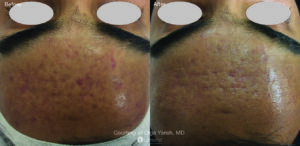
- Boxcar Scars – also typically found on the jaw and lower cheeks are boxcar scars. They account for approximately 20%-30% of acne scars[i] and are characterised by a round or oval-shaped appearance. They are also indented due to the way in which the skin heals around the lesion. Their shape often means that they can take longer to heal than other types of acne scars.
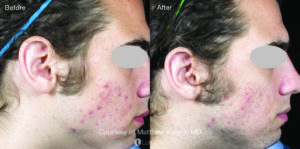
- Ice Pick Scars H4 – the most prolific type of acne scars (typically representing 60%-70% of total scars[i])ice pick scars are deep, narrow and pitted in nature and appear commonly on areas of the face where the skin is thinner, such as the forehead and upper cheeks.
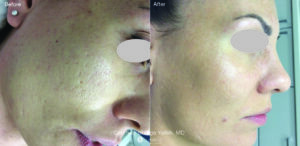
Raised Acne Scar (Keloid Scars)
Keloidal scars are associated with excess collagen deposition Raised acne scars, also known as keloid scars, appear as raised lesions or lumps of scar tissue due to extra collagen production that forms around the original acne lesion that extends the boundaries of the original area of damaged skin. They can differ in colour and can be pink, red, skin coloured or darker and are more common in skin of colour.[i]
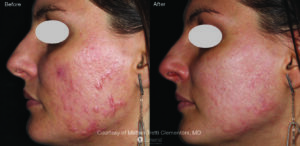
Blackhead Acne Scar
Black heads are a common yet mild form of acne and are open comedones. They occur when hair follicles or sebaceous glands become blocked, and their dark appearance is caused by an irregular light reflection off of the clogged follicle. Black head scars are easily treatable and are a relatively insignificant type of acne scarring.
Whitehead Acne Scar
Similar to blackheads, whiteheads are a mild form of acne and thus rarely cause significant scarring. They are caused by oil and dead skin blocking hair follicles or sebaceous glands and form a closed bump on the skin also known as comedones.
The Best Acne Scar Removal Treatment
As acne scarring is a common indication, it’s unsurprising that there are several treatment modalities to treat the condition. Scarring can be treated successfully in several different ways using a combination of or standalone treatments that include the following:
- Laser Treatment for Acne Scar
Laser resurfacing is one of the most effective ways of reducing and clearing acne scars.
Available laser treatments include ablative and non-ablative skin resurfacing. The choice of treatment depends on the type of scar (boxcar, rolling, or ice pick) and on the patient’s preferences and expectations in terms of number of treatments and downtime.
- Ablative resurfacing: ideal for patients seeking an amazing improvement in a single session.
- Non-ablative resurfacing: ideal for patients who prefer a milder treatment approach that requires several treatments but has less downtime.
- Microdermabrasion
A minimally invasive epidermal resurfacing treatment modality, microdermabrasion is thought to be advantageous when treating certain types of atrophic acne scars. It has been a popular treatment option across the globe and is considered safe for use on all Fitzpatrick skin types. It is not thought to be as effective on deeper ice pick scars, and in one study comparing scar treatments, microdermabrasion achieved the least significant results. A total of 27.3% patients did not achieve any benefit despite eight treatment sessions, and only 9.1% achieved good results.[i]
- Chemical Peels
Commonplace in clinical practice, chemical peels, used to remove dead cells and re-texturise the epidermis chemical peels vary in strength and efficacy and successful outcomes are based on a careful patient selection as well as appropriate use of specific peeling agents.[ii] Chemical peels tend to be more beneficial in treating mild boxcar acne scarring, or mild rolling scars. They are less effective when treating ice pick scars. Chemical Peels carry some risks and can make skin extremely sensitive. They should be used with caution on Fitzpatrick skin types IV to VI and patients should be fully consulted, and skin should be assessed to determine suitability.
- Steroid Injections
Due to their anti-inflammatory properties, and their ability to break bonds between collagen fibres to reduce the amount of scar tissue, steroid injections are commonly used as part of a wider acne scar treatment plan. Used due to their fast-acting properties, they are administered to treat scarring as opposed to the cause of acne itself.
- Microneedling
Research has shown that microneedling (a type of collagen induction therapy) is a simple and effective method of treating atrophic acne scarring. It has become a popular treatment modality in recent years due to minimal side effects and downtime associated with some available treatments. The technique uses multiple mini sterile needles to encourage the skin’s wound healing response and improve the texture of the skin. It can make keloid scarring worse so should be used under the guidance of a qualified aesthetic practitioner.
- Rejuvapen for Acne Scars
Rejuvapen is a type of microneedling that was developed specifically to treat acne scars. Working to the same principles as general microneedling and uses nine small needles to rejuvenate the skin’s surface.
- Dermal Fillers
A minimally invasive treatment whereby dermal fillers are injected into the skin to both stimulate the skin’s natural production of collagen, break up scar tissue and raise depressed areas of acne scars to improve the topography of the skin. Hyaluronic Acid based dermal fillers are a popular type of dermal filler for the treatment of acne scarring.
- Punch Excisions
Particularly effective for treating deep scar tissues, punch excisions are an invasive procedure to surgically remove scar types. The acne scar is removed using a surgical tool that matches the size of the scar (usually between 1.5mm and 3.5mm). The wound is then stitched closed.
Which acne treatment works the best?
Some of the world’s most prestigious aesthetic doctors and practitioners use the Lumenis Stellar M22 laser system to treat acne scarring. One of the latest cutting-edge systems from industry innovators, the Lumenis Stellar M22 device is a powerful multi-application platform that uses the latest technological advancements to achieve optimal results.
Innovative and intuitive, the device uses different types of wavelengths which can be used to treat different elements of acne, that can be combined to achieve different results. Firstly, the Stellar IPL treats active acne by shrinking the glands used to create sebum. The ResurFX non-ablative skin resurfacing laser, treats and minimises the appearance of the scarring itself and then the Q-switched Nd:YAG module can help treat the pigmentation that comes alongside the acne scarring.
Although it varies between patients, a typical treatment session using the Stellar M22 ResurFX lasts for 30-45 minutes. Treatment is bespoke to the patient and depending on the severity of the scarring, they may need to have three or four sessions, all spaced about six to eight weeks apart. This also enables practitioners to establish how the skin is responding to the treatment. Find out more about how to introduce the Lumenis Stellar M22 into your clinic here.
About Lumenis
Lumenis is a global leader in the field of minimally-invasive clinical solutions for the Surgical, Ophthalmology, and Aesthetic markets, and is a world-renowned expert in developing and commercializing innovative energy-based technologies, including Laser, Intense Pulsed Light (IPL) and Radio-Frequency (RF). For 50 years, Lumenis’ ground-breaking products have redefined medical treatments and have set numerous technological and clinical gold-standards. Lumenis has successfully created solutions for previously untreatable conditions, as well as designed advanced technologies that have revolutionized existing treatment methods. visit: www.lumenis.co.uk